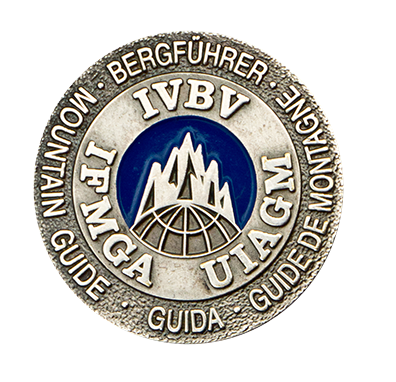A system to help glacier ski mountaineers avoid crevasse falls.
Close Calls with Avalanches
“A close call is a free lesson. ”
The fastest way to learn about avalanches is to almost get nailed by one. Not killed or hurt, just really scared. Where you can brush off the dust, thank Ullr, and analyze the shit out of what happened.
Psychologists say we learn best from instant feedback. An example of instant feedback is pulling on a small handhold while climbing. If we don’t fall off, we get instant feedback that we made the right decision. They also say—notably Malcolm Gladwell in his book Outliers—that we need 10,000 hours in an instant feedback environment to become an expert. That means you can become an expert sport climber after 10 years of clipping a lot of bolts.
Not so easy with avalanches.
The problem with avalanches is they rarely provide instant feedback to the backcountry skier. If we ski a 35-degree powder slope during considerable danger, and it doesn’t avalanche, we get feedback that we made the right decision. But what if we skied within a meter of a trigger spot, that would have ripped out the entire face? Then the feedback we got was wrong. And we learned wrong.
For us backcountry skiers, our best instant feedback on avalanches is when we actually start an avalanche. If you can accept that you’ve made a mistake, it’s time to debrief and learn. In the past couple years, I had three of these close encounters with avalanches. I survived, and learned.
Lesson #1: The Coffee Avalanche
In mid-April 2015 I was on my third Denali Ski Base Camp in a row. This trip was with the Eagle Ski Club to the Coffee Glacier area. It was our third day of skiing in a zone I’d also skied the week before. The weather was clear, calm and warm.

We started the day with a low angle glacier run to a steep moraine headwall. I stopped on the flat crest of the moraine and looked down to the powder field below. A client skied up to me on the flat moraine bench and said, “That looks good! Should we ski it?” I struggled with the desire for powder and a feeling the slope was not right. After all, I stood at this same place the week before and not skied the slope, but the powder looked so good….
Another client skied up and joined us on the moraine. We heard a small whoomph and the moraine wall below us fractured a meter deep. The avalanche sliced around the top of the moraine, ripping out of sight around the corner, spilling deep and heavy into the valley below. “Yeah, I guess we won’t ski that.”
After the avalanche we skied on northerly aspects, away from the runout of sun warmed slopes. The following days cooled, allowing us to ski steep chutes and powder fields with no more signs of instability.
What the Coffee Avalanche Taught Me
This was one of those situations where it’s normal, normal, normal, then boom! it’s not normal. It’s easy to become complacent when conditions remain the same for days on end. The problem occurs when there’s a subtle change in conditions, such as wind from a different direction, when we’ve let our guard down. Active backcountry skiers have all experienced those “I didn’t expect that!" moments.
So how do we stay mindful to changing conditions? One technique that Todd Guyn suggested at ISSW 2016 is to say, “What am I missing out here?” The statement promotes discussion and thought. I've seen this statement work miracles while teaching at the Alaska Avalanche School. It often gets the quiet person to speak up and the unseen is made apparent.
Another learning point from this avalanche was to watch the first warm day after a storm. What is warm? It’s when you drag your skip pole and the snow lumps around your basket instead of piling like dry sand. It’s when snow powder plops off solar aspects rather than puffing down as spindrift or dry loose avalanches.
This first warming and wetting of the snowpack from warmth—warmth from either solar or air temperature—can re-activate dormant weak layers. The wetted snow creeps and pulls downhill like a glacier, magnifying stress on weak layers below.
Lesson #2: Flattop Mountain Avalanche
In March 2015, two teenage brothers from Florida joined me for skiing around Anchorage. We first tried Turnagain Pass, but it was pouring rain. We drove back to Anchorage and tried the Chugach Front Range from the Glen Alps trailhead.
To introduce the brothers to the backcountry, we toured to the left edge of a 150-meter long wind slab to look at snow layers. The slope was about 15-meters high and tilted to 20 degrees, a full 10 degrees less than what’s normally considered avalanche terrain. I probed the pencil-hard slab with my probe, feeling a hollow layer of facets at the base, between the slab and rocks. A good place to show the brothers a weak layer.
As I dug a meter to the ground, I felt a collapse and the entire slab began to move, slowly breaking into massive blocks. One brother was off the slab. I stepped off the moving slab, only to realize the other brother was sitting on the moving blocks, laughing, like a rabbit in the car headlights. I stepped back onto the moving slab and drug him off. The massive blocks moved five meters and stopped. Riding out the moving blocks might have worked, but getting sucked under would have sucked.
What the Flattop Avalanche Taught Me
This was my big wakeup call about hard slab avalanches. They let you get out in the middle with no feedback, then they crack far uphill from you. They seem to catch more avalanche professionals than any other avalanche type.
This wind slab on Flattop seemed to have collapsed on the 20-degree slope where we stood and propagated 100 meters to where the slope steepened enough to move. The slab’s rigidity allowed it to pull out all the way back to the 20-degree slope where we stood.
Being so close to a popular trailhead, I immediately worried people would find out it was me who was involved. I worried people would question my decision making. Bystanders tend to judge the abilities of the people involved in avalanches. This phenomenon is a natural instinct known as the attribution bias, better known as Monday morning quarterbacking. This causes us to judge rather than learn from avalanche accidents. The attribution bias has another side. When an accident happens to yourself, you tend to blame the circumstances rather than considering the mistakes you made. Either way, the attribution bias prevents learning. It's like shooting yourself in the foot.
The Utah Avalanche Center has worked to shift away from a culture of blame in avalanche accidents. As former UAC director Bruce Tremper said to Sportgevity:
“At the Utah Avalanche Center, we have a strict policy to not criticize the decisions of people who tell us about their incidents. We don’t care who they are and what decisions led them to it. We just want to know about the avalanche activity and snowpack conditions because that can help to save other lives.”
As bystanders to avalanche accidents, we need to take the it-could-have-been-me approach. As someone involved in an avalanche, we need to realize we made a mistake. Whether bystander or someone involved, the objective from each avalanche should be to learn and be better prepared next time.
I met the Florida brothers the next morning for our second day of skiing. We actually nailed perfect conditions at Summit Lake. They told me they came to the conclusion that the avalanche was a rogue event. After thinking about it, I realized they were right. It was a rogue event. An outlier. They say snow is stable 95% of the time. That means avalanches are outlier events. Avoiding avalanches is about having an outlier mindset: to move a bit further out in the valley from the runout, to give the cornice a wider berth than is needed, to imagine the fracture line cracking higher than expected.
That wind slab was five days old. Wind slabs often stabilize in a day, but not when they’re over persistent weak layers like a thick layer of advanced facets—an outlier situation that I hope to recognize next time.
In a captivating youtube, Gordon Graham describes high risk/low frequency events in the fire service. He says these dangerous situations can be broken down into two groups:
High risk/low frequency events where you have time to think. The solution, Graham says, is to “Slow down. Slooow down. Sloooooooooow down.” Slowing down has become one of the points in my 2017 system for avalanche avoidance.
High risk/low frequency events where you have no time to think. The solution: Graham says, is “They can be addressed through serious training.” Train for worst case scenarios.
Lesson #3: Ski Hill Avalanche
The end of March 2016 was storms, rain and avalanches in Southcentral Alaska. A return client, one that I really cared about, came for a week in the Alaska Range. Despite a horrendous weather forecast, we flew into the Alaska Range for the experience. Pilot Paul Roderick took us to our first choice location, it was too windy to land. He took us to our second choice location, avalanches had ravaged the slopes. Eventually, we landed near the Mountain House in the Ruth Gorge, a place best for climbing, and not so good for making turns. One small slope, called Ski Hill, rises above the Mountain House.
Despite the gnarly weather, we had a blast camping and pumping 100-vertical meter runs on Ski Hill. The driving snow and raging wind made Ski Hill exciting and welcomed exercise. At the high shoulder of Ski Hill, where the slope steepens up to Mount Dickey, I probed with my ski pole and felt a hollow layer 50 centimeters down. I looked up and wondered if I was too close to the steeper slope above.
The next day, in the raging storm, we avoided avalanche terrain by climbing a rocky ridge in the raging storm. We went to bed that night with the tent banging around like a bear wanted to be let in. The morning dawned clear, calm and cold. North America’s most rugged mountains glowed white under a deep blue sky. I looked toward Ski Hill and saw a fracture line cutting across the slope above on Dickey. The debris has splattered across Ski Hill. Not down Ski Hill, but sideways across Ski Hill. I felt nauseous and went back inside the tent.
What the Ski Hill Avalanche Taught Me
I wondered why I skied so close to Dickey two days earlier. I had felt the weak layer. I knew the slope above had been loading. What was I thinking! The place where we stood had been obliterated by hundreds of tons of snow.
“Once you adopt a new view of the world (or any part of it), you immediately lose much of your ability to recall what you used to believe before your mind changed.”
This is called the Hindsight bias. The I-knew-it-all-along effect. We tend to distort the history of thinking in accordance to what we presently know. Hindsight is 20:20.
The Ski Hill avalanche was another reminder to look for outlier conditions. Ski Hill is probably safe 355 days a year. That means the outlier avalanche conditions occur 10 days a year. It’s those 10 days I need to watch out for. Like when it’s storming hard, I feel a weak layer and I’m feeling the pressure to satisfy clients. Then I need to adapt and listen to the mountains.
Summary
Use the it-could-have-been-me approach to learn from avalanche incidents.
Have an outlier mindset in avalanche terrain.
Remember that hindsight is 20:20.
To avoid complacency, ask “Is there something we missed?”
Slow down when you have time to think.
“I hope for watercooler conversations that intelligently explore the lessons that can be learned from the past while resisting the lure of hindsight and the illusion of certainty. ”
“...if the consequences would have been severe or the event caused you to change your decision-making or practices, call it a near miss.
”
2016 Denali Ski Base Camps
Among back-to-back trips last spring I had four Denali Ski Base Camps. Each trip confirmed my Denali addiction. It's not the kind of addiction that involves manhauling for days on snowshoes. Rather it's the kind of Denali addiction that involves skiing stable powder in big mountains with passionate people from around the world.

The first trip started with big weather. That's what can happen in big mountains. Here's Austin Ranz and Philipp Becker storm skiing in the Ruth Amphitheater. They are friends of Brint Markle (not in photo) who I skied with in 2013.

After the rager storm, it cleared and the Alaska Range emerged in typical glory.
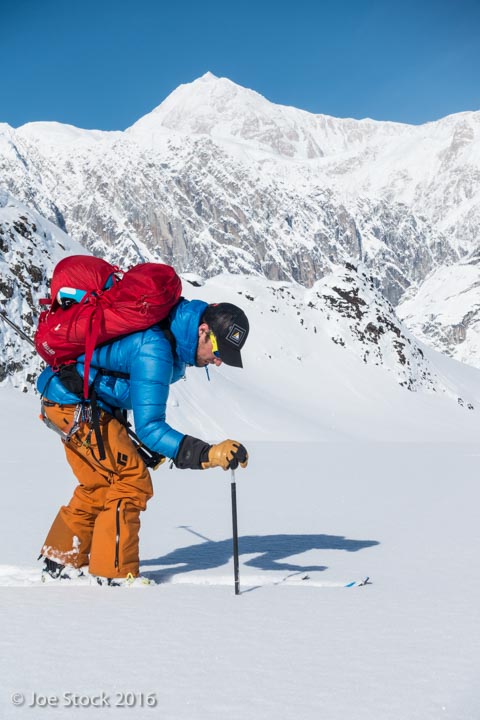
Brint testing a prototype of an Avatech snow measurement tool. Brint is the CEO of Avatech, a company that has tackled long-standing problems in snow measurement and information sharing. The company is going huge this year with Mountain Hub.

Mike Schmid and Bryan Herold, back in the Alaska Range. This was our third trip together including the Western Chugach and a Denali Ski Base Camp in 2015.
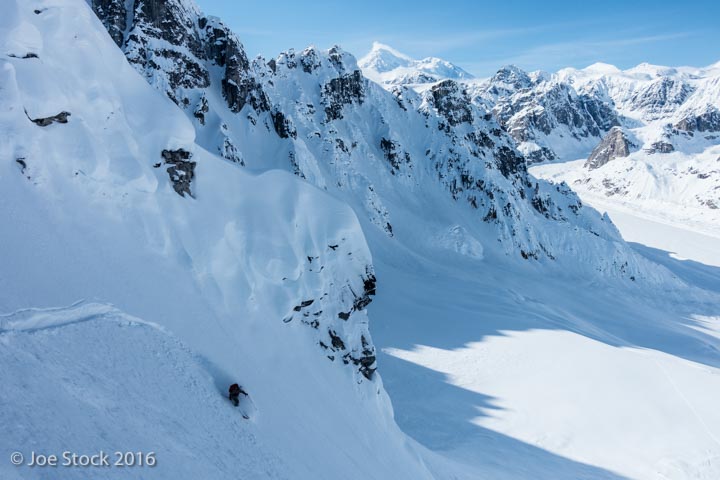
Mike modeling and testing snow quality for me. He does a good job.
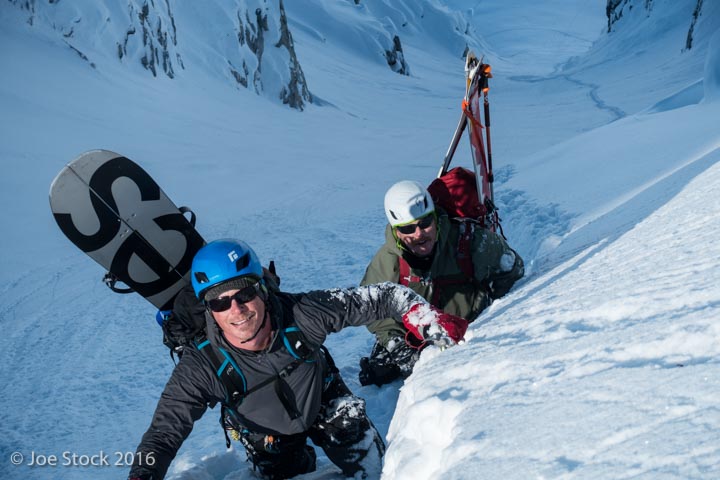
Booting two thousand feet of powder-filled coulie.

Mike below a run we called Flat Mike. At the summit, we took photos of Flat Stanley (a paper cartoon character) for his son. While in the chute, Mike took the skier's right gully, below the massive cornice. Watching from below, Bryan and I worried we'd be getting some flat Mike photos if the 40-foot cornice snapped off and steam-rolled Mike.
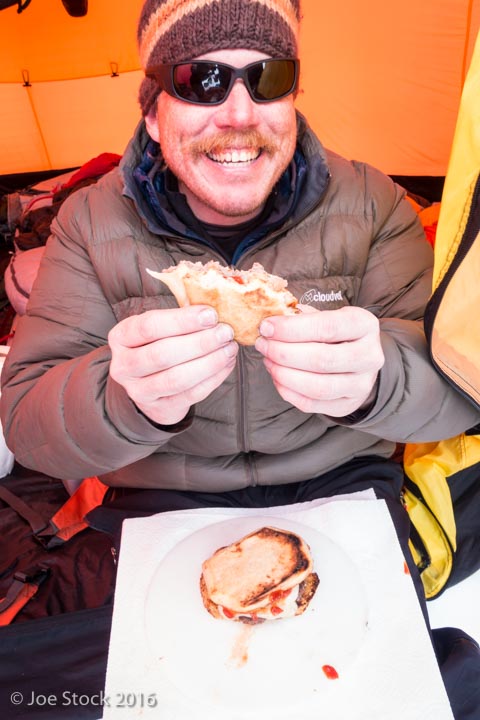
Mike doubling down on burgers.

First step into the Alaska Range with four Scots: Al Conroy, Jonny Lonie, Becca Rankine and Tom Collins.
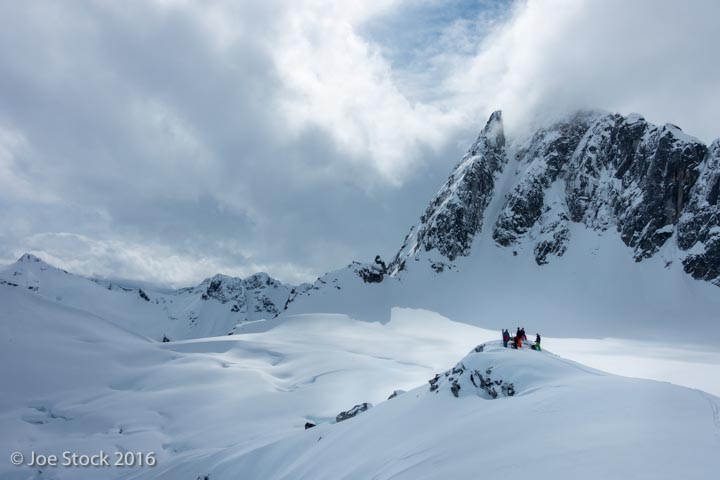
First tour of the trip with the Scots.

Safe zone to safe zone in pow-filled coulies.
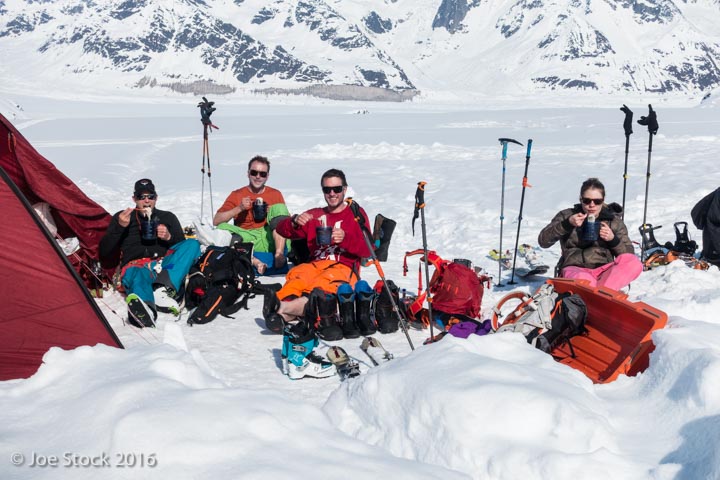
Mid-afternoon noodle break before another run.

Next year I want to ski out there, in those shady slopes and chutes. Anyone keen to go exploring with me?

Becca below an ice cliff. Leading into this line was the epitome of guiding for me: onsight in big complex terrain. A few days earlier, Canadian IFMGA Mountain Guide Cece Mortenson told me how lack of spotters had been a factor in some recent avalanche accidents in Canada, including Robson Moser. Following Cece's reminder to always have a spotter, I used a talkabout radio to leap frog a spotter down above me. At one point I made steep powder turns above this ice cliff, with Jonny spotting, until I found a sneak to skier's right, into this pow-filled glacier-bowl. My only mistake was not getting some ice for our selection of Scotch.
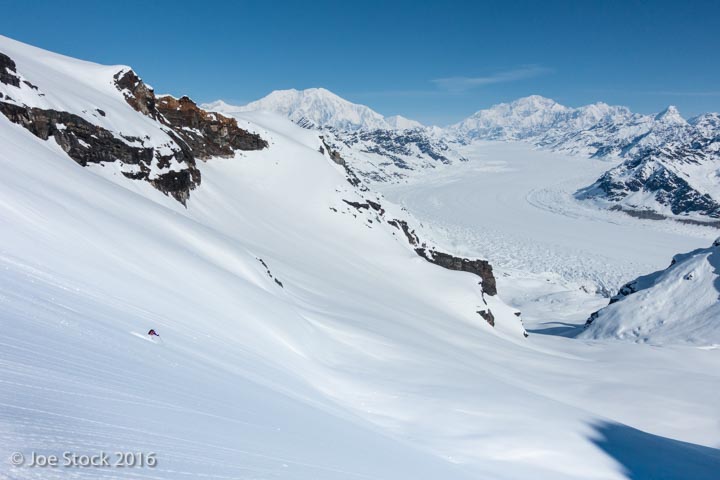
Becca modeling for my camera and testing snow quality into an unknown glacial basin. This valley exited into rolling moraine and a hanging terrace back to camp.
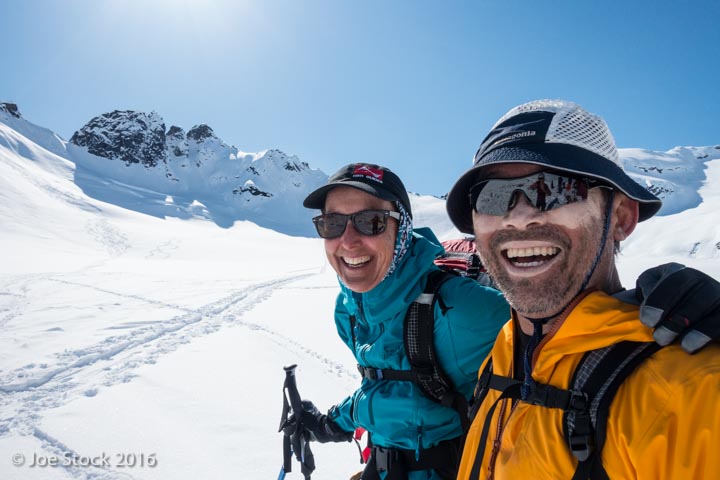
We camped near Jim and Sarah Sogi. They live in Hawaii and ski around the world, wherever the snow is good, which means I often see them in Alaska. Each evening we socialized with Jim and Sarah at their nearby luxury camp.

Booting another coulie to ski it's fluffy surface. I find photos of climbing chutes more captivating than photos of skiing chutes. Perhaps it's because the untracked snow gives that feeling of wanting to know what's ahead. Anticipation is much of the allure of backcountry skiing.

A few hours after leaving our neighborhood, Oliver Evans, Amy Downing and Ben Crawford (out of photo) summit an Alaska Range peak. Last year Oliver and I skied steep north facing powder in the Western Chugach. This year we planned to ski again, somewhere. As the date approached, conditions looked best in the Alaska Range.
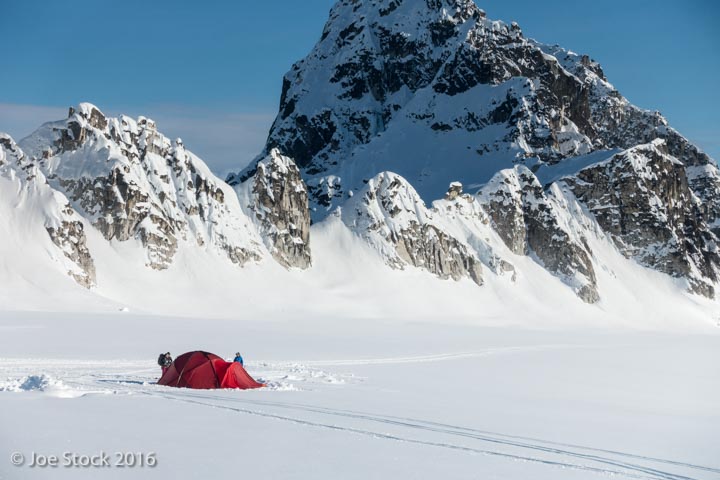
Base camp. Jim Sogi loaned me this vestibule for my Hilleberg Atlas.
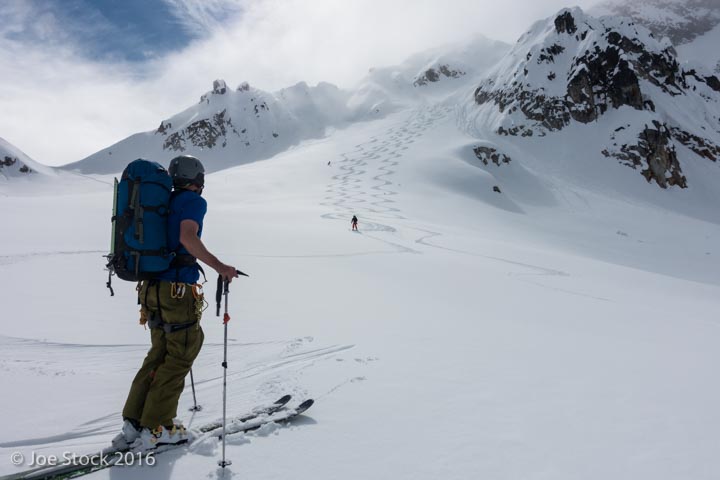
Powder and corn in early May.
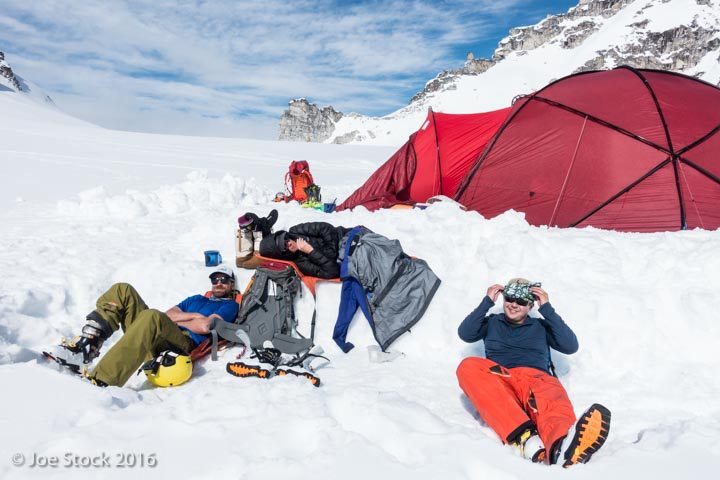
Beating the afternoon heat.
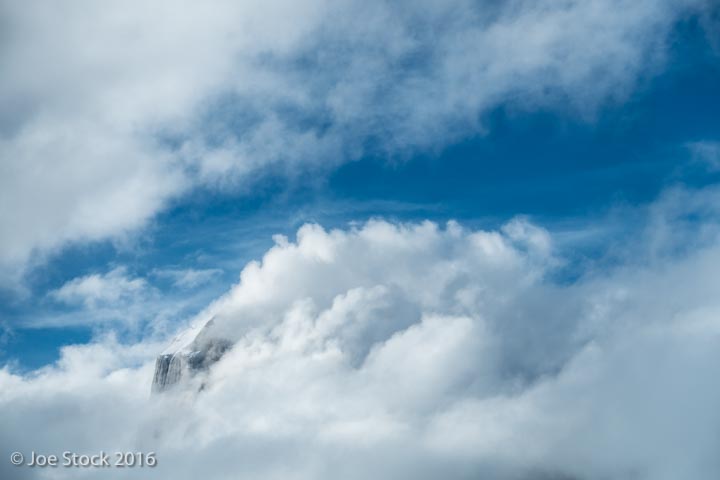
The Broken Tooth.
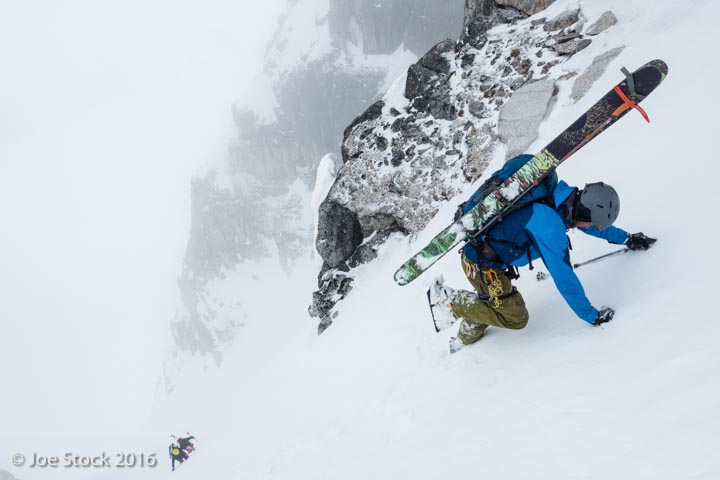
Clouds cloaked our mountains on the third day, so we skied near the rocks for visibility. This was a striking chute that I'd ogled over last spring.

Amy ready to ski.
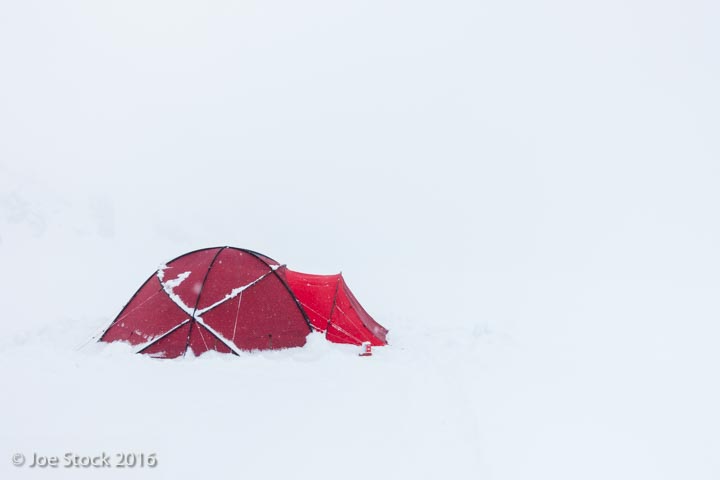
After two runs among the rocks, we headed back to the tent and listened to an entire season of Serial, about an Army deserter in Afghanistan. At 6pm, Pilot Paul Roderick picked us up to return to Talkeetna.
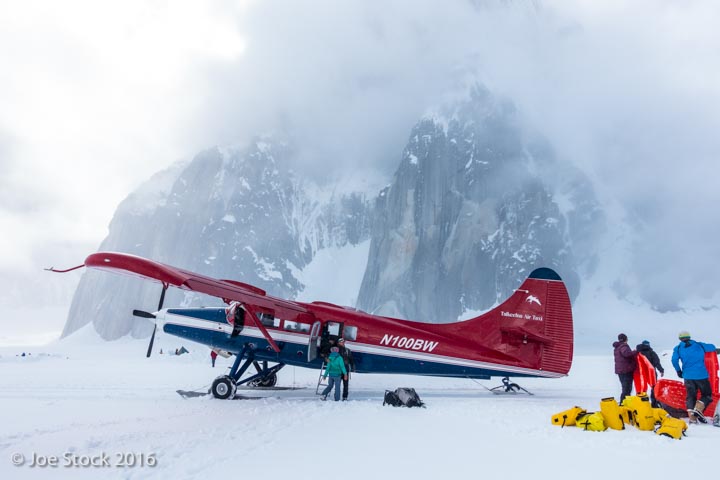
We stopped at the Ruth Gorge base camp to pick up some French climbers. Back in Talkeetna, we realized the small town was packed with weather-delayed climbers waiting to fly in. Turns out, our flight was the first and only flight all day. Paul is good to us like that.
Thanks for the fun trips everyone!
